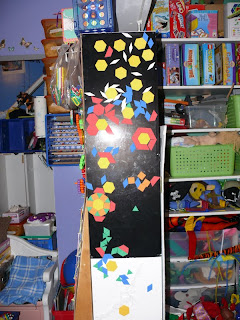(Forward facing book shelf made with a scrap of trim attached to the back of an existing book shelf.)
(Magnetic "Magic Walls" added to the side of the bookshelf)
Lately, I have been working to utilize our shelving units to their maximum potential. If you remember, awhile back, I made a flannel story board on one of our large white shelves. You will find the full tutorial here:
Finally a Flannel Board. The book shelves have traditionally been placed with the back up against the wall, but recently, I decided that it was a poor use of space to use them in that manner. Now, I am using them to help divide areas of the room, by anchoring the side of the shelf to the wall instead of the back.
The shelf pictured above is anchored to the wall by the side. On the back of the shelf, pictured above, I made a giant pegboard/gearboard/geoboard. I didn't take a lot of photos in the process, but here is the basic run down:
1) Buy your pegboard. I used the 1/4" thickness board. I like it better because it is sturdier and the holes have a wider diameter.
2) Cut the pegboard to the size you would like to use. I didn't want mine to cover the full length of my shelf, so I measured and cut the board to the size .
3) Paint if desired
4) Add nuts and bolts to the board in the area you plan to use as a gear and/or geoboard. I used #6 nuts and bolts that were 1 1/2 " long. I would recommend testing different sizes to determine the best ones for your project. You want to make sure that they are wide enough to support your gears (but not too wide that the gears won't fit!) I also wanted part of the peg board to be used as a peg board, so I did not add the nuts and bolts to the full area. In order to accommodate my gears I put the bolts in every other hole, skipped a row and then for the third row, I alternated every other hole opposite the first row. Skip a row then repeat the first row, etc. (I hope this is clear. I'm including a photo up close to help those of you who are visual like I am).
5) Attach your board to the back of a book shelf. If you are using part of it as a peg board, make sure to leave some space between the board and the shelf. (Otherwise you won't be able to hook your accessories in.) I also added a wedge to the sides on the bottom. We cut a 2x4 section at an angle to make our wedges.
Make sure to anchor your pegboard the wedge and the wedge to the bookshelf. It is not necessary to do this, but your gears will work much better if you do. (When you do not have the angle that the wedge provides, your gears lean forward.)
6) Play and Enjoy!!!!
This shelf now has activity and storage on 3 sides! I cut the back of the shelf to open up the bottom to allow the gear basket and felt story buckets to be accessed from both sides. If you remember my initial flannel board, it actually was aligned with the bottom shelf. I lifted it up to open the bottom up for storage.
I do plan to add a rain gutter shelf to the bottom of the dark brown backing of the shelf in this photo for some of our books, especially those that have to do with gears and shapes.
The flannel board is still on the other side, I just moved it up a shelf! So, there is an open shelf on the bottom where the story pieces are kept along with the gears. There are 3 shelves behind the board for storage of smaller items that I do not want readily accessible because of the young children in my care. The top shelf is also open for storage.
The "Magic Wall" on the side of the shelf is from Dowling Magnets. I have never tried the magnetic paint, but I have been told by more than one person not to waste my money. Magic Walls are thin magnetic boards that you can apply to the wall. I cut this one in half and stacked the pieces on top of each other in order to cover the side of the shelf. Right now, we have the magnetic foam shapes out, but I have a wide array of other magnets available for the children to explore.
Our chalkboard made with the homemade paint is holding up quite nicely. (It does need a good scrub though!) We turned another book shelf and made the back into a forward facing shelf:
This was super easy to do, and I made it with a scrap of trim that was dropped off by a friend.
Cut the trim to the length of the book shelf, pre-drill holes to prevent the trim from cracking, attach the trim to the shelf with a screwdriver... and voila! Forward facing shelves!
The shelves still need a coat of paint, and I will probably add a dowel length to each shelf to help support the taller books. (They like to lean forward a little bit.)
I love all of the DIY, and I am super excited to be making better use of our book shelves! Do you have any creative ways to better utilize your shelves?













Comments
Discovering Montessori
www.theworkplan.blogspot.com